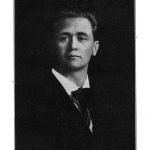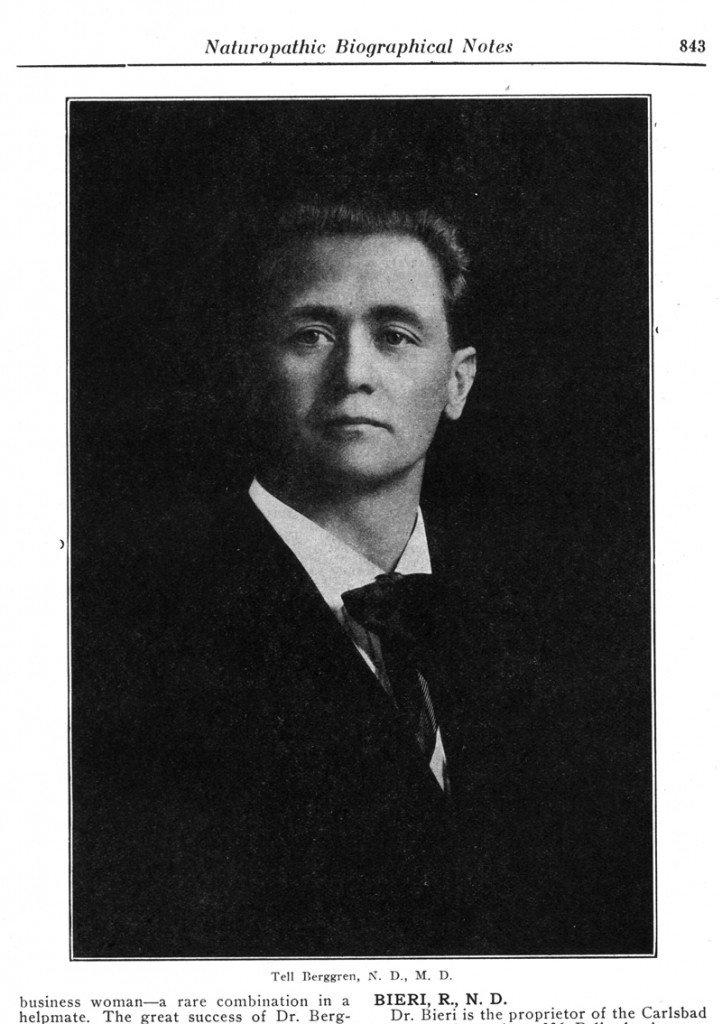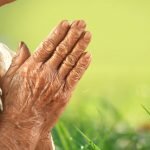Sussanna Czeranko, ND, BBE
I was covered with fresh rhubarb leaves from head to foot with just enough space left on my face to give me a chance to breathe. Afterwards I was given what the Germans call a ‘Rumpfbad,’ a trunk bath.
Tell Berggren, 1915, p.687
I rose early and took a leisurely bath in the lake on a shallow place about a foot deep.
Tell Berggren, 1916, p.15
[Mrs. Svardstrom] does know, however, that a skillful combination of an harmonious mental attitude with her simple regimes generally instills such a love for simple, natural living in those who follow her directions, that they continue the simple life after returning home.
Tell Berggren, 1916, p.228
Adolf Just [1859-1936] wrote his revolutionary book, Return to Nature, in 1896. It would transform people’s relationship with Nature forever. Adolf Just put Nature on a pedestal as a desirable environment, and with the creation of his “Jungborn,” a place where people could go and live completely in harmony with Nature, he essentially brought Nature into Naturopathy.
Just’s Jungborn was one of his crowning achievements. It was a Nature retreat center, or sanitarium, located in the Harz Mountains in Germany, and it was soon visited by thousands. After the publication of his classic book, people around the world gravitated to his theories of disease and curative practice. They came tired and left inspired. Many returned to their homelands and would follow in Just’s footsteps, building their own Jungborns. Benedict and Louisa Lust did just that.
We have seen how Louisa and Benedict Lust created their Jungborn on a 60-acre parcel of land in the Ramapo Mountains in Butler, New Jersey. Another disciple, Emanuel Felke, visited Just in 1897/1898 and returned to Repelen with plans for his Jungborn and even a second site, located in Bad Sobernheim, Germany. Another who was deeply enchanted with Adolf Just and was inspired to live the natural life was Mrs Svardstrom in Sweden. We learn about Svardstrom’s work through the writings of Tell Berggren.
Tell Berggren’s 7-Day Cleanse at Halsohem
Tell Berggren,* a physical culturalist, lived in California (Figure 1). He returned to Sweden to visit his homeland, and included a stop at Mrs Svardstrom’s Swedish Jungborn, “Halsohem,” in Haradsviken, where he experienced a week-long cleanse comprised of a fast in its healing environment. The 7-day cleanse incorporated modalities and regimes from several famous natural healers, including Adolf Just, Johann Schroth, Louis Kuhne, Father Sebastian Kneipp, as well as innovative methods that Mrs Svardstrom herself added to her customized program.

In a series of articles, Berggren recounts his sojourn at the Swedish Yungborn and the activities of his stay. Berggren experienced a beautiful lake surrounded by wooded hills and the silence of Nature. The accommodations were modeled after Just’s Jungborn, featuring among other facilities an “air hut [that] opened on one side and bordered a large enclosure shaded by apple trees.” (Berggren, 1915, p.687) His air hut was located on the shore of a pristine lake, and each morning he would rise and would begin his day with an early morning swim. People who resided at the Swedish Yungborn wore loose-fitting clothing and sandals. These were novel and bizarre in this time period and enjoyed only by those who had the fortune to become acquainted with Adolf Just or Kneipp and naturopathic philosophy.
Mrs Svardstrom’s Fruit Cure
On the first day new patients fasted, and then for the following days followed Mrs Svardstrom’s fruit cure. “The famous cure consisted of nothing but a small plate containing between one and two dozen of good ripe strawberries two times a day and a wine glass full of grape juice once a day.” (Berggren, 1915, p.688) Mrs Svardstrom advised her patients not to drink freely, but rather limit their water consumption to 1 or 2 glasses.
The “dry diet” was popularized by Johann Schroth, who may have influenced Mrs Svardstrom’s fruit-cure protocol. They both included grape juice and wine as the beverage dosed out in very limited quantities. However, Mrs Svardstrom fed her patients fresh strawberries, and Schroth relied on dry bread as the basis of his diet.
Rhubarb Sauna
After Berggren’s swim, he enjoyed a sun bath, which was followed by a “rhubarb leaf sweat.” Berggren describes his experience: “Stretched out in the hot sun on the soft grass, I shivered with delight during this genuine nature treatment. I was covered with fresh rhubarb leaves from head to foot with just enough space left on my face to give me a chance to breath.” (Berggren, 1915, p.687) The combination of rhubarb leaves and the hot sun engaged the largest depurative organ, ie, the skin, to cleanse by profuse perspiration.
Trunk Bath
Following the rhubarb leaf sweat, a “trunk bath” was taken in the Kuhne manner. Louis Kuhne had perfected the trunk bath by adding friction during this 20-minute bath, taken in cool water of 30 °C / 86 °F. Using a coarse cloth, the lower abdomen and genitals are rubbed while the patient’s body is submerged in a low-lying bathtub. The friction hip bath was used as the primary modality by Kuhne for the thousands of patients who flocked to Leipzig for a cure with this master of healing. There was much opportunity to bask in the bosom of Nature, quietly in repose and in reflection. Berggren chose to spend his afternoon resting, reading, and writing in the shade of the apple trees.
Days 2 and 3
Berggren’s second day began as the first, with an early-morning dip followed by a walk into the woods. Breakfast was a plate of strawberries and a small glass of grape juice.
On the third day of his fruit-cure diet, he went for a long walk followed by a swim. After his swim, he “practiced the Müller system of friction exercises until dry.” (Berggren, 1915, p.689) He was surprised that this strenuous exercise regime was easy despite his strawberry diet. Returning to the Yungborn, he was invited by some children staying at the Halsohem to go for a row in the row boat and another swim. When meeting Mrs Svardstrom that afternoon, he was scolded for “indulging in so much strenuous exercise while [he] was practically fasting.” (Berggren, 1915, p.689)
Rudolf Steiner’s Visit
The serenity and news of Halsohem traveled far and wide, bringing many visitors from other countries to Sweden. Berggren describes his meeting with a group of Germans visiting Halsohem, and 1 very distinguished guest – Rudolf Steiner, the founder of Anthroposophy. Steiner and his party of Germans and Swiss had come to stay as guests at Mrs Svardstrom’s Halsoham. They were enchanted and showed much appreciation for the beautiful and simple Nature Life facilities at Halsohem. That evening, July 13, 1914, Rudolf Steiner was speaking at a nearby town 5 miles away, and Berggren attended. What is so astonishing is that Berggren, on a modified fast, walked 5 miles to hear Steiner’s lecture at 8 PM, and then walked home another 5 miles to arrive at midnight to eat his supper meal of a plate of strawberries. How often have some of us declined to attend an evening event, even when we most often have the luxury of a car?
The next morning, Berggren began to read one of Steiner’s books – Initiation and Its Results – and he read a passage that he did not completely comprehend but with which he was deeply intrigued. His meeting with Rudolf Steiner had kindled a desire to pay more attention to his inner thoughts. Berggren reflected upon his stay, commenting, “I felt that the simple regime of Mrs Svardstrom conscientiously and lovingly followed out in this paradisiac atmosphere could not but help to instill such a love for real simple nature living, that we would crave it under all circumstances and choose it whenever we had the liberty to do so.” (Berggren, 1916, p.14) As a man who studied and lived the life of physical culture, Halsoham offered many opportunities for exercise in fresh air.
Days 6 and 7
The sixth day began with a leisurely bath in the lake. “A nice floor of boards had been laid over the mud on the bottom, which made the water cleaner and pleasanter to bathe in.” (Berggren, 1916, p.15) The temperature of water used in the water treatments themselves was guided by fasting. Berggren explains: “Mrs. Svardstrom does not believe in full cold baths while fasting as they are generally too exhausting.” (Berggren, 1916, p.15) Most of the patients took their daily Kuhne friction trunk bath, and also followed in the footsteps of Father Sebastian Kneipp by walking. “Walking in the wet grass as well as on the boarded floor in the lake” (Berggren, 1916, p.16) followed by sun baths were regular daily activities enjoyed by the patients.
Berggren’s week-long fast at Mrs Svardstrom’s Halsoham filled him with mental clarity and increased vitality. He says, “The longer I fasted, the more I seemed to really enjoy life; my thoughts were clearer and I felt as easy and unconcerned as a bird.” (Berggren, 1916, p.15) He chose to come to Mrs Svardstrom’s Halsoham to fast and be surrounded by Nature. He continues,
I tried to explain the reason why I thought I needed at least one such week a year. Not alone that I might be able to keep my body fresh and vigorous, cleansed from poisons and youthful, but that my spirits might feel free to soar to greater and loftier heights; to forget for a little while the struggle and the heart cry of the world for help in their misery, in order that I may store enough inspiration and life so that it could flow so much freer to the relief of hungry souls and bodies.
(Berggren, 1916, p.227)
To contextualize the time that Berggren is writing, it is helpful to know dates. Tell Berggren visited this health retreat center in Sweden in the summer of 1914 – July 11th to 17th – just days before World War I was declared on July 28, 1914. He wrote articles about his 1914 Swedish Yungborn visit for Benedict Lust’s journals in 1915 and 1916, during the throes of WWI, but prior to American entry into that war. He had visited France during the war and witnessed “more agony of body and soul as a result of the war than during [his] whole previous lifetime.” (Berggren, 1916, p.227) His reflections of his fasting experience appropriately describe the sadness that he is witnessing during the war.
On the seventh day of his fast, he had another rhubarb leaf sweat that was followed with a dip in the lake and strawberry breakfast. He had fasted during his week, and then left to visit his wife and sister. He walked 5 miles through hilly terrain to a steamer boat that crosses Lake Vettern. The final stage of his journey was by train. At each stage of his journey home, he drank milk with great gusto, reporting, “On arriving at Norrkiping I had … O JOY! … two full glasses of real fresh, sweet MILK not too cold, which I took care to Fletcherize thoroughly.” (Berggren, 1916, p.295) Indeed, over the next 3 days, Berggren’s appetite for milk became ravenous. The “Milk Cure” was another therapy common and popular in the early 20th century, which we will revisit in a future article.
A New Sense of Health
It is important to note that Naturopathy, then, as now, has had many forms of expression. Tell Berggren traveled from his health center, the Coronado Health Home in California, to Sweden to find a place to participate in a cleanse. What did Beggren accomplish on his week-long fast? Definitely health and serenity. But in his words, “Incidentally you may then discover that what you have imagined as real health before was not really health at all. When all your sluggishness of mind and body like by a miracle has left you, when you have no unhealthy cravings or desires, then you are beginning to more fully realize what perfect health is.” (Berggrenn, 1916, p.297)
The Swedish Yungborn that Mrs Svardstrom created helped people to reclaim their health by following a simple dietary regime with the serenity of Nature as their teacher. Fresh from that experience, Berggren wrote, “Health means a great deal more than mere freedom from sickness. It means joy and enthusiasm, vim and endurance.” (Berggren, 1916, p.297) Perhaps as we navigate our patients towards health in our naturopathic practices, striving to help them find exuberance and joy along with disease management, we can keep Berggren’s words and Svardstrom’s “Jungborn” in mind as models of what is possible. Berggren demonstrates that health is much more than physical relief. Berggren was much affected by his trip to Sweden. He outlines the true purpose for being healthy: “It is our duty not alone to ourselves and our immediate family, but to coming generations as well as to society as a whole to always be in the highest pitch of health possible.” (Berggren, 1916, p.297)
*Tell Berggren was Swedish, with a Swedish name. Its spelling took 2 forms in Lust’s journals: Tell Bergren and Tell Berggren. I have adopted the second spelling, since it appeared more often in the Lust journals and is most likely the correct Swedish spelling.
 Sussanna Czeranko ND, BBE, incorporates “nature-cure” approaches to primary care by including balneotherapy, breathing therapy, and nutrition into her naturopathic practice. Dr Czeranko is a faculty member working as the Rare Books curator at NCNM and is currently compiling a 12-volume series based upon the journals published early in the last century by Benedict Lust. Four of the books have been published: Origins of Naturopathic Medicine, Philosophy of Naturopathic Medicine, Dietetics of Naturopathic Medicine, and Principles of Naturopathic Medicine. In addition to her work in balneotherapy, she is the founder of the Breathing Academy, a training institute for naturopaths to incorporate a scientific model of breathing therapy called Buteyko into their practice. She is a founding board member of the International Congress of Naturopathic Medicine and a member of the International Society of Medical Hydrology.
Sussanna Czeranko ND, BBE, incorporates “nature-cure” approaches to primary care by including balneotherapy, breathing therapy, and nutrition into her naturopathic practice. Dr Czeranko is a faculty member working as the Rare Books curator at NCNM and is currently compiling a 12-volume series based upon the journals published early in the last century by Benedict Lust. Four of the books have been published: Origins of Naturopathic Medicine, Philosophy of Naturopathic Medicine, Dietetics of Naturopathic Medicine, and Principles of Naturopathic Medicine. In addition to her work in balneotherapy, she is the founder of the Breathing Academy, a training institute for naturopaths to incorporate a scientific model of breathing therapy called Buteyko into their practice. She is a founding board member of the International Congress of Naturopathic Medicine and a member of the International Society of Medical Hydrology.
References:
Berggren, T. (1915). At the Swedish Yungborn. The Naturopath and Herald of Health, XX (11), 687-690.
Berggren, T. (1916). At the Swedish Yungborn. Herald of Health and Naturopath, XXI (1), 14-15.
Berggren, T. (1916). At the Swedish Yungborn. Herald of Health and Naturopath, XXI (4), 226-228.
Berggren, T. (1916). At the Swedish Yungborn. Herald of Health and Naturopath, XXI (5), 295-297.



